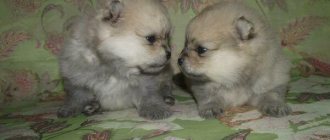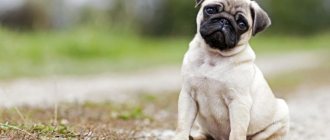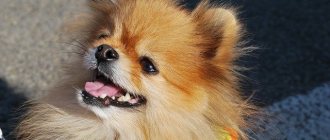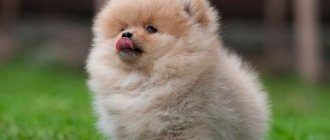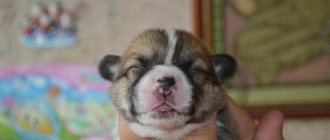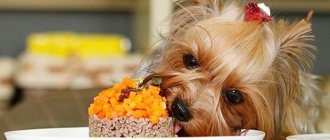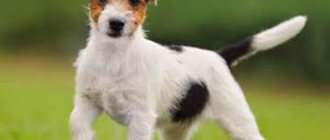The Pomeranian is a miniature dog, which today is one of the most popular among those who like small breeds. Therefore, any information regarding their care is very relevant for Spitz owners. Among the many issues that concern Pomeranian owners, a special place is occupied by those related to the gestation and birth of Spitz puppies.
The period of pregnancy and the birth process is a time when attention and support are very important
This is not surprising, since the period of pregnancy and the birth process for Spitz dogs is a special time when they need attention and support. After all, this breed has long ceased to be part of the wild, becoming completely domestic. Therefore, a little mother cannot cope without the help of her owner. The appearance of little Spitz dogs means not only cute photos on Instagram, but also a lot of troubles and responsibilities.
How many puppies are there in the litter?
Most girls of this breed do not have multiple births, so the average litter size for Pomeranians is 2-3 babies.
The size of the litter largely depends on the size of the bitch.
If the girl is small, weighing approximately 2-2.5 kg, then she will most likely give birth to small or medium-sized litters of puppies.
A larger dog can give birth to 4-6 puppies.
Growth and size of the Pomeranian Spitz by month
In accordance with the AKC (American Kennel Club is a non-profit canine organization that maintains a registry of purebred dog breeds), the height of Pomeranians ranges from 18 to 22 cm, and weight from 1.4 to 3.5 kg.
Puppies at birth can weigh from 90 to 120 grams, and intensive growth, to the standard size of an adult dog, occurs before 12 months. As the puppy grows up, it changes beyond recognition, transforming into a charming fluffy dog.
Pomeranian puppies may grow slightly in height until they are 15-18 months old before they are fully formed.
Spitz weight table by month, weight in grams
Main features of mating Pomeranians
Mating Jack Russell Terriers for the first time: how long does estrus last?
The duration of puberty in Spitz dogs takes a lot of time; you should not rush into mating. First of all, you need to know exactly what you plan to do with the puppies in the future, whether sale is possible. Pregnancy and childbirth are not always favorable for the dog and can negatively affect its health, so you should seriously think about it before mating.
Before mating, you should study all the features and make an accurate decision.
It is also recommended to remember that a pregnant and lactating bitch will require additional care and quality nutrition, so if it is not possible to provide it, you should refuse mating.
The procedure is carried out on the male dog’s territory so that he feels more confident and the female dog does not show aggression. It is better to choose a place that is familiar to the dog.
It is better to put a muzzle on the lady or secure her so that she does not frighten off her partner with excessive aggression. There should be no strangers nearby during mating.
Application
Spitz dogs are mainly bred for fun. Due to their high adaptability to the lifestyle and living conditions of people, pets are suitable for families with children, the elderly and single people.
Their lively, good-natured character has made dogs good psychologists. They are used by psychotherapists in working with withdrawn children and adults with post-traumatic syndrome.
At the same time, dogs are watchmen and security guards. They are always on the alert, warning about the visit of uninvited guests and danger. And if something threatens the owner, they will defend themselves without hesitation.
The qualities of protectors are more pronounced in large varieties of the breed. So, the German Dwarf Spitz is just a toy. He doesn’t even want to go outside again. Another thing is a large German Spitz, Keeshond or Mittelspitz. They will not be afraid of the most formidable and powerful enemy.
What do newborns look like and when do they open their eyes?
Newborn Pomeranian puppies don't look much like those fluffy babies in advertising pictures. They are born completely blind and deaf, with a body covered with rather sparse and very short hair.
Babies at this age look disproportionate and not nearly as attractive . Their head is large and slightly flattened, their body is elongated, their legs and tails are relatively short, and their bellies are voluminous.
Pomeranians begin to see the light approximately 10-15 days after they are born..
Differences between male and female
The gender of a Miniature German Spitz affects the dog's appearance and personality. For example, boys have the following:
- larger body;
- very fluffy and thick coat;
- Shedding is easier because less hair is lost;
- increased emotionality;
- They are almost incapable of cunning and manipulation.
But for a German Spitz Minik girl the following is characteristic:
- cleanliness;
- more balanced, calm character;
- the ability to manipulate and deceive;
- less expressed emotionality;
- frequent long-term shedding: before estrus, after childbirth.
But regardless of whether it is a girl or a boy, the pet will be devoted to its owner to the last, like a child.
Contraindications to vaccination
Sterilization of dogs: at what age is it better to do it?
A dog is not vaccinated in several cases:
- on the eve of visiting the veterinary clinic, the pet came into contact with an infected four-legged friend;
- the dog has poor appetite;
- deworming was not carried out beforehand;
- The pet has hyperthermia.
Apathy in a puppy
How it develops from 1 to 12 months
| Puppy age | Description of the stage of growing up | Sizes (medium, for standard size puppies) | Weight (k - dwarf, m - mini, s - standard) |
| 1 month | From about the third week, small Spitz dogs begin to cut their teeth. At this time, puppies behave restlessly, often bark and try to chew everything. Closer to the second month, the main traits of character and temperament are formed. During this time, it is very important that babies interact with other dogs and people. | 7-12 cm | k - 210-275 g m - 325-370 g s - 460-490 g |
| 2 months | The puppy begins to acquire a characteristic appearance: its coat lengthens and becomes fluffier, however, it does not reach the same density and length as in adult dogs. | up to 14 cm | k - 320-460 g m - 550-620 g s - 680-770 g |
| 3 months | The puppy's fur is gradually beginning to be replaced by the adult's, however, at this age the shedding is not yet too noticeable. The babies look like those adorable fluffy puppies from advertising photos. And at this time it is already possible to determine with greater or lesser probability what color they will have. | up to 16 cm | k - 460-690 g m - 800-920 g s - 1.0-1.15 kg |
| 4 months | Little Pomeranians' teeth change and they begin to shed more frequently. Most puppies at this age do not look as attractive as before: almost all of their baby hair has already come out, and their adult hair has not grown back properly. | up to 17 cm | k - 600-880 g m - 1.0-1.175 kg s - 1.3-1.45 kg |
| 5 months | Puppies continue to shed, but by this age some of them already have enough hair to look almost as attractive as when they were young. | up to 18 cm | k - 700-1030 g m - 1.2 - 1.35 kg s - 1.55-1.7 kg |
| 6-9 months | Shedding continues until about 7-9 months, but in some Spitz dogs it is more pronounced, in others less. By 7 months, baby teeth should be replaced by permanent teeth. And at about 7-9 months the first heat occurs in girls of this breed. | 18-20 | k - 770-1150 g m - 1.3-1.5 kg s - 1.7-1.9 kg |
| 12 months | By this age, the Pomeranian will shed again, but its coat will acquire its final appearance and texture by the age of three. | 18-22 | k - 1.0-1.4 kg m - 1.7 - 1.9 kg s - 2.1-2.3 kg |
| Adult | The dog has reached its final physical development and is in the prime of life and beauty. | 18-22 | k - 1.0-1.4 kg m - 1.7 - 1.9 kg s - 2.1-2.3 kg |
Interesting facts about German Spitz dogs
German Spitz dogs have pronounced leadership abilities, for which breeders in their community call them “Napoleons”. If you do not pay attention to upbringing and training at an early age, puppies will grow up to be overly excitable, disobedient dogs that attack strangers.
The dog's thick fur is never completely cut off, but it is regularly shortened on the ears, paws and in the groin area.
Another interesting fact about German Spitz dogs is that their coat (especially the coat of Wolfspitz dogs, the largest representatives of the breed) does not have the characteristic dog smell.
Types of vaccines
To vaccinate Spitz dogs, monovalent and polyvalent preparations are used. Most veterinary clinic specialists prefer the second type, as it allows you to minimize the time of vaccination and protect the animal from infection with dangerous viruses. But some owners prefer monovalent products, arguing that complex vaccines place an excessive burden on the puppy's immune system and can provoke disease.
List of the most commonly used monovalent vaccines:
- against canine plague - “Vakchum”, “Biovac-D”, “Multikan-1”, “Canivac C”;
- against parvovirus enteritis - “Biovac R”, “Nobivak Parvo-C”, “Primodog”;
- against leptospirosis - “Nobivak Lepto”, “Biovac-L”.
Polyvalent drugs against canine distemper, hepatitis, adenovirosis, coronavirus and parvovirus enteritis, leptospirosis and parainfluenza in various configurations:
- "Kaniwak CH";
- "Multikan-2"
- "Biovac-RA";
- "Triovak";
- Trivirovax;
- "Nobivak DHP";
- "Nobivak DHPPI";
- "Tetravac";
- "Multikan-4";
- "Multikan-6";
- "Hexakanivac";
- Biovac DPAL.
"Multikan-7" in addition to the above diseases prevents infection with ringworm, and "Multikan-8" - rabies.
How to care?
Considering that Spitz fur needs regular combing and sometimes grooming, it is advisable to start accustoming your pet to these procedures as early as possible.
The baby needs to be combed with a wide-toothed comb for 10-15 minutes a day so that he gets used to grooming..
Small puppies should not be bathed too often, and it is very important to dry the coat thoroughly with a hairdryer after washing.
Also, from the very first day, the baby begins to be accustomed to a tray or diaper. To do this, you need to take it there every time after eating or sleeping.
Puppies' nails are trimmed often, as they grow faster than in adult dogs . At the same time, it is very important to carry out this procedure without coercion and, if possible, avoiding accidental injury to the baby.
NOTE!
The teeth of the Pomeranian Spitz require special attention from the owner during their replacement period, since these dogs sometimes have problems due to the baby fangs not falling out in time.
If the owner of the puppy notices that one or more milk teeth have not fallen out, and permanent ones are already growing in their place, then it is necessary to take the pet to the clinic to have them removed.
Daily care should also include eye and ear examinations . This is done not only to find out whether they are dirty, but also to timely detect the first signs of inflammation.
To clean the teeth, you can let your puppy chew on toys purchased at a pet store or special treats..
If plaque forms too quickly and the puppy cannot remove it on his own, then you need to brush his teeth with a dog toothbrush and toothpaste intended for animals.
History of the German Spitz breed (small, medium and large)
As mentioned in the article, the German Pomeranian (see photo above) is a fairly old breed, existing for more than 2,500 years. This is evidenced by images of dogs on tablets and ancient dishes. Previously, only ordinary people kept such pets, since they guarded no worse than large dogs, and ate much less than them. Of course, maintaining them was very profitable. In addition, the Spitz dog was intended to protect estates and property, plantations with various plantings, accompany shepherds, protect livestock from predatory animals, and simply for the entertainment of the owners.
The modern history of the German Spitz breed (both small, medium and large) began only in the 18th century, when the fashion for these dogs appeared among aristocrats. At that time, Germany was divided into regions and each of them carried out its own work on breeding dogs of a certain color and size, now more attention was paid to their exterior. For example, in Krefeld, Aachens and Düsseldorf, mainly Wolfspitz dogs were bred, in Württemberg, black and brown dogs, and in Pomerania, miniature dogs. It is noteworthy that the miniature German Spitz breed, a photo of which is presented in the gallery after this review, was the favorite pet of Empress Catherine, Mozart, Michelangelo and other great people.
After some time, dogs spread widely throughout Europe and became favorites of the nobility. The white German Spitz was in great demand, and a little later - orange and brown. In the 19th century, the breed appeared in America and attracted the interest of local breeders. At the end of the 19th century, the English Spitz Club was created, where exhibitions of these dogs began to be held. In 1891, the first breed standard was approved. The dogs were divided into 2 categories: the first included dogs weighing up to 2.5 kg, the second - those whose weight was more than 2.5 kg. Today, Pomeranians bred in America are considered the best in the world. They are distinguished by their compact size, harmonious physique, strong bones, and have fast, precise movements. Their thick fur can be of different colors and rich tones.
In Germany, the breed gained its second popularity in 1899, when German Spitz lover Charles Kammerer, widely known among dog breeders, sent letters to all admirers of such dogs, in which he proposed to unite and support its development. In 1900, an organizational meeting was held in Frankfurt am Main, as a result of which the German Spitz Club was founded, a Stud Book and a manual for breeding and registration were created.
In France, for a long time, German medium-sized Spitz dogs were bred, which at that time had an external resemblance to dogs from the past, that is, they resembled their ancestors with pointed and long muzzles, had thick hair, but without dense undercoat. They did not have a lush “collar”. Interestingly, modern large and small German Spitz are similar to French Spitz, but have a more compact build and regular movements.
In Spain, German dwarf Spitz dogs were bred, which became the favorite pets of Spanish women - aristocrats, who, due to the traditions of inbreeding, were not particularly beautiful, so they surrounded themselves with dwarf servants, as well as dogs that were considered unattractive in those days, and against their background they seemed more beautiful.
In Denmark and the Netherlands, large and small German Spitz and Keeshonds lived on barges and ships, where they caught rats and mice and guarded property.
At the beginning of the 20th century, the breed was divided into 3 groups, each of which had its own size: large - 45 cm at the withers, medium - below 38 cm, dwarf - from 25 cm. Since then, dogs have become even more interesting, and their number fans have increased significantly. The world wars that engulfed Europe in the 20th century reduced the number of Spitz dogs, and some of them were exported to Eastern Europe.
The breed appeared in Russia at the end of the 19th century. In each region, dogs differed in appearance and behavior. Only wealthy people could breed them, so small dogs personified “bourgeois luxury” in our country. At the beginning of the 20th century, exhibitions began to be created in large cities, where about fifty German Spitz dogs gathered. However, they were soon replaced by other foreign breeds. In the 21st century, the German Pomeranian Spitz regained its former popularity in Russia, which was mainly due to the new import into the country of dogs that meet modern international standards.
Preparation
To ensure that the birth of your Spitz proceeds and ends without problems, thoroughly prepare for it, consult with a veterinarian, and watch videos. Thanks to video preparation, you can be in the right frame of mind and be prepared for what will happen and what it will look like.
Pregnancy lasts about two months. While the bitch is carrying puppies, preferably no later than a week before you plan to give birth, prepare all the necessary conditions:
- Choose a room where no one will disturb you.
- Remove all unnecessary interior items.
- Immediately when the first signs of impending labor appear, clean and ventilate the room and disinfect the room.
- Remove all strangers from the room. Besides you, only a veterinarian can be there.
Among other things, the room needs to be equipped. Install a spacious maternity box with two compartments - in one the bitch will give birth and rest there after the process, and in the second the newborn puppies will lie so as not to interfere with the ongoing birth.
Prepare the place
In about 10 days, or better yet two weeks, transfer the pregnant Spitz to the maternity room and teach it to boxing. This way you can prepare the bitch, and during childbirth she will lie quietly in the equipped place.
Mandatory set of equipment and first aid kit
In addition to boxing, you need to prepare the following things:
- disposable diapers;
- rags for wiping puppies;
- thermometer;
- sterile gauze wipes for wiping the puppy’s mouth;
- office and scales to record the parameters of each cub;
- sterile scissors for cutting the umbilical cord;
- an antiseptic drug for sterilizing navels, for example, Xidikol;
- silk threads for ligating the navel;
- emulsion of 10% synthomycin to avoid the inflammatory process;
- a clock to record the time between contractions and the birth of each baby.
In addition to the items listed, before giving birth you need to collect a first aid kit so that, if necessary, you can take resuscitation actions to save the litter:
- oxygen balloon;
- warmer;
- a heart stimulant, for example, Cordiamine;
- enema to remove mucus from the mouth of babies;
- No-shpa ampoules;
- 5% glucose solution;
- calcium gluconate.
24 hours before the planned birth, prepare the dog for the procedure:
- Wash your stomach and genitals with soapy water;
- trim hair around the nipples, vagina and anus.
Trim the hair around the nipples. Immediately before the process, prepare yourself - trim your nails, disinfect your hands, prepare medical gloves.
Signs of impending labor: temperature and behavior
A week before giving birth, the expectant mother’s tummy begins to sag, the vagina becomes soft and increases in size. After a few more days, the uterus drops and the back sags. Immediately a day before labor, the Spitz’s body temperature drops to 37 degrees.
Find out which dogs are most similar to Spitz.
The bitch's behavior changes and signs of nervousness appear. She begins to rush around, whine and look for a place. Toxicosis and apathy towards food may appear.
At this point, the delivery room should be completely ready to “receive patients.”
The main sign of approaching labor will be the way the bitch begins to breathe - heavy, rapid breathing appears. The dog will follow the owner's heels, give it maximum time and reassure the expectant mother.
Sometimes Spitz dogs show practically no signs of approaching labor. So that this day does not come as a surprise to you, starting from the 56th day of pregnancy, take your temperature twice a day. Do this when the dog is calm - early in the morning or late in the evening.
Attention ! Do not induce labor artificially. This can lead to uterine rupture and other injuries. Only a veterinarian can give a stimulant.
If you decide to walk your dog before giving birth, make sure that it does not start giving birth on the street. If this happens, do not miss the puppy's exit, pinch the umbilical cord with your fingers and tear it off, cover the baby and immediately go home.
If labor begins 70 days after mating, contact your veterinarian. The reason may be health or a frozen pregnancy.
A clear sign of impending labor is the appearance of chills, as well as whining of the bitch. Spitzes often arch their backs or lie on their sides before contractions.
Spitz contractions
A few hours before giving birth, the bitch may have a light brown discharge. This means that the process of rejection of the mucus plug has begun.
Dry, clean and plenty of food
Once you have decided on a breeder, ask him to give you an introductory tour. Ideally, it should show not only the puppies and their parents, but also the entire nursery as a whole: the conditions of keeping the Spitz, supplies and names of food. If the breeder feeds the dogs natural food, then the place where the food is stored and their expiration dates. If there is plenty of fresh and high-quality food, it means that the owner does not skimp on the health of his charges.
Another indicator of a good attitude towards puppies is cleanliness and dryness in the places where they live. German Spitz dogs do not have a specific dog smell, so if they smell bad, it means they are not well cared for.
The owner of the nursery must competently answer all your questions and show an official permit for the breeding of Spitz dogs, issued by the RKF (Russian Cynological Federation). If he cooperates with foreign nurseries, then he must also have agreements concluded with them.
When examining the puppies' parents, you may find that the bitch will look much worse than in the "before" photo or according to the breeder's stories. This is not his fault, it’s a matter of the specifics of the breed. The closer the birth is, the more intense the Spitz bitch's shedding. As a result, the luxurious “fur coat” disappears, giving the dog a shabby appearance. With good nutrition, the coat should recover within two to three months after birth.
What to feed for the first 3 months?
From about the third week, puppies can already begin to be fed solid food . It is most convenient to start complementary feeding with a scraper.
To do this, take a piece of muscle meat and run the edge of a spoon along its side several times. Small balls, slightly larger than a pea, are made from the scraped meat, and one piece is fed to each of the babies.
Some breeders replace scraped meat with minced meat, but this is incorrect, since minced meat is less easily absorbed by the puppy’s body..
Later, babies begin to be introduced to other foods: cottage cheese mixed with kefir or natural yogurt, as well as porridge added to meat and vegetables.
In addition to beef, small Pomeranians can also be fed rabbit meat, turkey or lamb . But it’s too early to give offal at this age.
Then, it will be possible to add boiled sea fish without bones to the diet, and give boiled chicken yolk twice a week.
IMPORTANT!
If you decide to feed the puppies with ready-made food, then this should be done from the very beginning, after the kids try scraped meat for the first time.
In this case, their diet will consist of branded food no lower than super-premium class, which should be soaked in warm water in the first three months of the puppy’s life.
You can also feed puppies wet commercial food that is suitable for their size and age..
Thorough inspection
The puppy should have a neat appearance, that is, a fluffy, clean coat, a thick undercoat, without curls or waves. There shouldn't be a bad smell or sticky hairs. A small amount of fine white dandruff is acceptable, but large yellow particles may indicate the development of a fungus or the presence of worms.
Please note that from four to five months a Spitz may begin to shed, and this will significantly spoil its appearance. But you can easily view the structure of the puppy’s body and determine whether it meets the standard. In addition, the true color begins to appear, whereas before molting it may have been completely different. By the age of one, the color and structure of the coat are finally formed, and by the age of two, the head is formed.
The baby's skin fits tightly to the body without forming folds. Wounds, rashes, inflammation, ulcers with pus, scratching, bald areas are signs of poor care or skin diseases.
Carefully feel the puppy's torso, paws, tail, belly, head, ears - there should be no creases or open fontanel. The tummy is straight and elastic; its swelling or hollowness indicates problems with digestion or the work of worms. Examine the anus. It, like the fur around it, must be clean. If your puppy has soft ear cartilage, it means he doesn't have enough calcium.
There should be no dirt or purulent discharge in the ears and eyes of the Spitz. A cold, wet nose may produce a few clear drops, but not a lot of green or white discharge. The mucous membrane in the mouth should be pink; a white tint indicates a diseased heart or worms.
Count your fingers - there shouldn't be any profits. The dental system of a properly developing puppy has 12 strong white teeth. Only a scissor bite is acceptable. However, dwarf German Spitz dogs can also have an overbite.
How to feed correctly and how often
You need to feed the puppy from a bowl specially designed for this, at a certain time and in the same place.
The pre-measured daily portion should be divided into approximately equal parts according to the number of feedings.
In this case, it is best if the baby eats cottage cheese with kefir or yogurt in the morning, and at all other feedings - meat or fish with porridge and vegetables.
When feeding dry food, it is necessary to measure the portion very carefully, given that Pomeranians eat very little at a time, it is best to use an electronic scale.
The number of feedings depending on the age of the puppy should be as follows:
- 2 months - 5 times a day
- 3-4 months - 4 times a day
- 4-6 months - 3-4 times a day, depending on individual needs
- 6 months - 2-3 times a day.
- 8 months and older - 2 times a day
Dry food should not be mixed with natural products, as this can lead to serious health problems for the dog..
Nuances in the development of different subspecies
The maturation of different types of Spitz proceeds approximately the same. Regardless of the breed, the development from a baby to an adult dog takes three years. They reach their final size by about six months.
There are some features:
- One litter may produce pets of different weight, height and color.
- A miniature size that does not meet standards may indicate the presence of diseases. Harnesses and collars are not suitable for these puppies. They should not jump from heights to avoid damaging their joints.
- If your pet is larger than the accepted standards, accept it. Most often, the reason is the presence of large individuals in the pedigree. It is impossible to influence the size of a pet without harming its health.
Start of the process
When labor begins, you should be there so that the dog feels your support.
When there are several hours left before birth, the fetuses stop moving, and the vagina greatly increases in size. Sticky, colorless or gray-green odorless discharge appears. This is the mucus plug coming off. The pet begins to feel chills, this is noticeable by trembling and rapid breathing. The body of the Pomeranian Spitz is preparing - the cervix is dilating.
Just before the birth of the offspring, the bitch's water breaks. But you may not even notice this discolored spot, since the dog can lick it off.
When the birth canal is completely open, intense, prolonged contractions begin - contractions of the muscles of the uterus, which alternate with pushing - contractions of the abdominal muscles. At this moment, the bitch tries to find a comfortable position: she either lies on her side or stands with her back hunched.
The duration of contractions varies from ten minutes to two and a half hours. If this time has passed and there is still no fetus, then it is necessary to urgently call a doctor. Most likely, the dog cannot cope on its own and needs a cesarean section. You cannot hesitate to call - this can lead to death of the Pomeranian or litter.
Each puppy comes out completely with a few pushes, either head first or feet first. Both options are considered normal. It is possible that when the first puppy is born, the pet will moan in pain, but other babies should not cause her such inconvenience.
During the process, you cannot feed or water the Pomeranian. Also, you should not disturb the bitch with unnecessary actions. It is better to just quietly and calmly observe the birth until your help is really needed.
After the birth of each fetus, an afterbirth is released, which the bitch usually eats. Do not forbid her to do this - the afterbirth contains substances useful to the dog’s body. But you shouldn’t let him eat more than two afterbirths, otherwise the Pomeranian will start to have diarrhea.
Try to change the diaper after the birth of each baby - keep the maternity ward clean.
If the birth goes as expected and the dog is able to cope with the process, then she herself accepts each puppy in turn, gnawing off the umbilical cord and licking it thoroughly, thereby freeing the baby from mucus and stimulating blood circulation.
If the bitch is tired and could not break the natural bladder in which the fetus is located, do it yourself - carefully tear the membrane near the baby’s head. After this, clear the puppy's airways of mucus.
If the baby breathes calmly and turns around in his arms, then everything is fine with him. If the puppy is lethargic, then you need to massage his chest, thereby stimulating his vital activity. If the newborn is not breathing or there is no membrane around him, you should immediately use an enema to suck out any fluid that has entered his mouth.
If the bitch was unable to bite off the umbilical cord, then you should do it. Quickly trim it with sterile scissors, leaving two centimeters. After this, treat the navel with an antiseptic. Don't even think about tying the umbilical cord in a knot.
Typically, a Pomeranian will give birth to one to three puppies. In case of multiple births, puppies are born at intervals of fifteen to thirty minutes. In between contractions and pushing, you can give your dog water or tea with honey.
All puppies must be placed in a prepared box so that during the continuation of labor the bitch does not crush her babies. If there are no lumps when you feel the uterus and abdomen, then labor is over. After the end of labor, you need to place the newborns at the mother's nipples, and leave the new family to rest and enjoy life.
How was your dog's birth?
If you found this article useful, please share it with your friends.
Advantages and disadvantages of Kleinspitz
Advantages of the German Spitz:
- Sociability, friendliness. Thanks to these qualities, the minik will quickly get used to a new home and a new family.
- Wits and intelligence. The breed is well trained and quickly remembers commands.
- A small German Spitz can be trained to go to the toilet at home. For this you only need a tray.
- Compactness. It is convenient to take your pet with you. After all, the dimensions of the German mini-Spitz are 23-29 cm at the withers.
- Tolerates changes in climatic conditions, temperature and cold changes well.
The relative disadvantages of the German Kleinspitz include the following:
- The need for careful coat care, especially during shedding.
- The next disadvantage follows from the previous one - the ability to cause allergies.
- If there is a lack of upbringing, the pet will chase other people's animals and get into fights with them.
- Touchiness. This baby can harbor a big grudge against its owner.
- Jealousy. The miniature German Kleinspitz will not allow its owner to communicate with anyone else. A person is his property.
- Inability to be alone. Otherwise, the apartment will be seriously damaged.
- Loud barking. An ill-mannered pet will bark for every reason.
First vaccinations
The first vaccinations are given at approximately 2 months. By this time, the immunity received by the puppy from its mother’s milk is already beginning to weaken, and therefore, if the babies are not vaccinated in time, they will catch literally every infection.
As a rule, puppies, and even adult dogs, are given complex vaccines that protect them from several diseases at once..
Such diseases include leptospirosis, hepatitis, distemper, parainfluenza and enteritis - that is, the most dangerous infections for animals, which, even with early treatment, often end in the death of the pet.
CAREFULLY!
They are especially dangerous for puppies, and therefore it is very important to strictly follow the vaccination schedule suggested by your veterinarian.
Usually, the first vaccine is given at 8-9 weeks . Two weeks after it comes revaccination, which should not be skipped under any circumstances. After this, the dog is vaccinated at 6 and 12 months.
Starting at 12 weeks, the puppy will also need to be vaccinated against rabies..
Health of Spitz puppies: vaccinations and vaccinations
Like any dog breed, Pomeranians require vaccinations. When puppies are weaned from their mother, they are wormed and then given the first vaccination (at 1.5 - 2 months). The next vaccination occurs 2 - 4 weeks after the first. For 10 – 14 days the dog is in quarantine and does not walk outside, and after that you can safely take the puppy out for walks.
Advice! If you walk your Pomeranian in the spring, treat it against ticks! Apply drops to the withers, which the veterinarian will recommend, or buy special shampoos or a collar. After walks, carefully inspect your dog for parasites. If you find a tick, go to the vet immediately.
Possible complications
Your dog may experience the following reactions, which are considered normal after receiving the vaccine:
- lump at the injection site;
- apathy;
- loss of appetite;
- diarrhea;
- hyperthermia.
After 3-4 days, such complications should disappear. Otherwise, you will need to call your veterinarian.
Important! If an animal begins to have convulsions or vomiting a day after vaccination, you should immediately contact a veterinary clinic.
How to choose?
When purchasing a pet, you need to treat it as responsibly as possible: study the basic requirements of the standard, conditions of keeping and feeding.
Also, even before purchasing a puppy, you need to purchase what you will need to care for it: toys, shampoos, a bed, a bowl, a tray, etc..
In order to avoid unpleasant surprises associated with purchasing a mongrel puppy instead of a Pomeranian or problems with the pet’s health, it is recommended to contact a club or kennel.
At the same time, you need to formulate your wishes regarding the puppy as precisely as possible: you need a show dog or a dog for breeding, or maybe just a pet.
Based on this, the breeder will be able to select the most suitable puppy for the buyer..
Before buying a baby, the future owner needs to check whether its exterior meets the breed standard, and also make sure that the puppy is healthy.
A small Pomeranian should have a compact, almost square body, strong, thick paws, a muzzle that is not too long, but not too short, and a fairly convex skull..
His back is not sagging, and his stomach is only moderately retracted. In this case, the puppy should look quite dense and well-fed, with clean eyes, ears and skin.
The color of the baby may differ from the color of the coat that he will have after growing up.
For example, red dogs are born brown and only gradually acquire an orange tint to their coat.
However, black , white and brown Pomeranians should look as uniform in color as possible, since even the slightest extraneous tint is not allowed in these colors .
Caring for Pomeranian puppies
Caring for a Spitz puppy should begin from the first days of its arrival in the house. It is necessary to make it a rule to monitor the health and appearance of the baby. Be sure to examine your eyes so that they do not fester or leak. It is advisable to check your ears once a week and, if earwax collects there, clean them. You only need to clean the outer ear, without getting into the ear canal.
When changing primary teeth, the healthy growth of molars should also be checked. Often, small dogs are left with lost primary canines and make it difficult for the primary ones to grow properly. Such procedures will help not to miss the abnormal development of the dog’s bite, and will teach her to allow her teeth to be examined without resistance if necessary, for example, by a doctor or at an exhibition.
A place to sleep must be chosen in advance. It will be necessary to gradually accustom your puppy to his new home, since, for sure, the baby will not immediately sleep in the place designated for him. The little family member will initially prefer to choose his own favorite places to sleep, based on his habits and smells. But the sleeping place is determined by the owner. And it should not be in the hallway or kitchen.
Do not place the puppy in drafts or near a radiator. Make sure that the place is not cold and uncomfortable. Your pet needs a place where he can sleep peacefully at any time of the day or night.
The best thing is the bedroom or near it, because Spitz are very attached to their owners and, if they are separated from them even by rooms, they are very worried about this and feel lonely, especially at night.
For sleeping, you need to purchase a basket for dogs , a mattress, replaceable pillowcases and diapers. Slowly accustom your baby to your house. From time to time, put “sweets” or favorite toys there, so the dog will associate the “official” place with pleasant impressions.
How to bathe a Spitz puppy
Before swimming, make sure there are no drafts throughout the house. Close the windows, vents and doors! Just like small children, small puppies are sensitive to drafts and can get sick.
Let your pet's first bath be a pleasant experience. Spend it in comfortable conditions. Place a cloth, diaper or rubber mat in the bathtub. Protect your pet's ears from getting water by carefully inserting cotton homemade earplugs into them.
Many dogs love to wash themselves and are happy to let them undergo water procedures, understanding that this is how the owner shows his love and care for them.
Pomeranians should only be washed with special shampoos for dogs, not for people. This is strict! Shampoos for dogs contain a certain pH, which cleanses the coat (lint and undercoat) well without irritating the dog’s skin.
Dilute the shampoo in a ladle with warm water and carefully pour this solution over the entire surface of the animal’s fur; you can also apply the shampoo with a sponge. Avoid getting water and shampoo into your eyes! Gently massage the animal's lathered fur, then rinse thoroughly with clean water and repeat once more.
After this, wring out the fur, let the dog shake itself, pat it dry with a towel and dry it with a hairdryer, using a gentle setting so as not to burn the baby’s delicate skin. It's better to use a hairdryer. If desired, you can purchase a special hair dryer.
What to do after childbirth ends
After the process is completed, the bitch is very exhausted and may not ask for food. Give your mother a drink using water sweetened with honey or weak tea. Do not use sugar so that fermentation does not begin in the Spitz's stomach. If the bitch asks to eat, give a small portion of fermented milk products.
Prepare a litter box so your dog can do his business. If she asks to go outside, carry her in your arms and limit her movement.
After giving birth, pay attention to hygiene. Wash the area near the vagina, stomach and area near the anus with a weak solution of potassium permanganate or furatsilin.
Watch your pet very carefully. If you notice the appearance of discharge that has an unpleasant odor, immediately contact your veterinarian - this may be a sign of the onset of an inflammatory process.
Cheerful mischievous puppy
Now it's time to inspect the litter. Observe the behavior of Spitz puppies from afar. Children with a healthy psyche should have an active life: running around, playing with each other, communicating with their mother, good appetite, regular toileting.
A puppy hiding in a corner or behind its mother's back is most likely cowardly. One who bites his fellow creatures is aggressive. Bursting with barking for no reason - with mental disorders. If your baby sits in one place and does not pay attention to the world around him, he may be sick.
Focus your attention on the puppy you like. When walking, a small Spitz should not limp, drag its paws behind it, have a sagging back or a drooping tail. He should have a smooth, elastic gait, free and springy running, a firm, confident stance with a straight back, a tail in a ring, raised up and lying on his back.
Be sure to wait until the puppy goes to the toilet. Liquid, bad-smelling stool is a sign of worms or an infectious disease.
Come closer - the puppy should not be afraid of your appearance. On the contrary, get interested and run towards the unknown. A lively, brilliant and perky look indicates the normal development of the baby. Take your Spitz in your arms; he should not struggle, bite, whine or bark. Only healthy interest and active sniffing. Perhaps light nipping or licking of fingers as a way to play.
